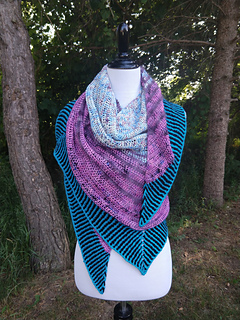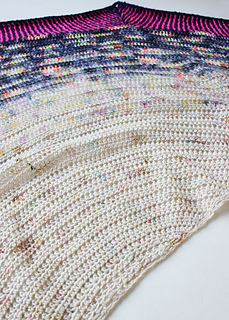patterns >  Zeens and Roger's Ravelry Store
Zeens and Roger's Ravelry Store
> Rapture










Rapture
This crescent shawl is a fun and stripey number that uses a basic form of interlocking crochet on its edging to create the brioche effect that is so popular in knitting right now. You can use a whole array of yarns should you wish. Here I’ve used a luxury sport weight yarn, a fluffy 2ply silk/mohair combo and a bargain wool/acrylic blend that I’ve had in my stash for at least six years!
This shawl would work really well with lots of different colours and different combinations of stripes. Crochet is a fantastic medium to play with; go for it and come up with your own unique take on this original design!
Materials:
- La Bien Aimée, Merino sport “Winter Garden” (100g, 325m/355yds, 100% merino). Yarn A (YA). Easy Knits, Tribblettes 2ply “Sunset Lustre” (50g, 420m/459yds, 72% mohair, 28% silk). Yarn B (YB).
- Garnsurr, Sokke merino 4ply “Tarik Roshan” (100g, 425m/464yds, 75% superwash merino, 25% nylon). Yarn C (YC).
- Countess Ablaze, Lord Longwool fingering “Rebelling Against Suburbia” (100g, 350m/382yds, 100% Wensleydale). Yarn D (YD).
- Stylecraft Life 4ply, “Navy” (100g, 450m/492yds, 75% acrylic, 25% wool). Yarn E (YE).
- 4mm & 4.5mm hooks
- Stitch markers (a minimum of 6 suggested for the increases of the main body or you can use lengths of contrasting yarn (see notes below). And at least 1 for the non working yarn on the border.)
(This might be helpful - I have 22grams left of yarn A, 36g of yarn B, 32g of yarn C and 35g left of of yarn D. I can’t find the stuff I used for yarn E but a similar amount to YD is used!)
Yarn alternatives: I’ve used 5 colours in this shawl, in 5 different types of yarn. You can use any mix of sport weight, 4ply/fingering to achieve a similar effect but this shawl should be wet blocked, therefore 100% acrylic yarn is not recommended.
Tension: Whilst tension isn’t critical for this project, it will affect the amount of yarn you use. First 10 rows of pattern in La Bien Aimée sport weight high twist: 7.5 x 30 cm / 2.75 x 12 in
Measurements: (measurements are approximate) 208x65cm / 82x25.5inches
Abbreviations:
BPtr = back post treble (US BP double crochet)
Ch = chain
Ch-sp = chain-space
Dc = double crochet (US single crochet)
FPtr = front post treble (US FP double crochet)
Htr = half treble (US half double crochet)
Pm = place marker
Tr = treble (US double crochet)
Ss = slip stitch
St(s) = stitch(es)
Notes:
- Intermediate crocheters will find this a fun challenge, some aspects of the border classify it as a “difficult” pattern.
- The 2ch at the beg of rows counts as 1htr. You may wish to use a standing htr to start each row instead (they’re easier to see) but I haven’t!
- If using 2ch at the beginning of rows it’s helpful to use a stitch marker.
- The 4ch at beg of rows counts as 1tr & 1ch.
- When working the edging, you must use a stitch marker to stop the yarn you’re not using from unravelling.
- For edging, all Yarn D (YD) stitches are made in YD stitches and all Yarn E (YE) stitches are made in YE stitches.
- Where the pattern allows, in the main body you can carry yarn up the sides as you work. Otherwise, fasten off and attach new yarn.
- Once past the set up rows, there’s no need to be exact with placement of the extra increases, it’s far more relaxing not to have to count stitches each row. Move markers as you go. Or use lengths of yarn to mark your way.
- First published: July 2018
- Page created: July 18, 2018
- Last updated: February 9, 2021 …
- visits in the last 24 hours
- visitors right now





